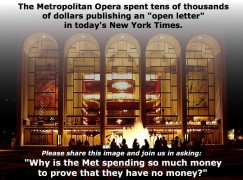Here’s how the Met musicians, in a statement today, see the future financial control of the house, with the manager Peter Gelb dependent on the approval of an external scrutineer.

Throughout these contentious negotiations, a clear question emerged: What has been driving increased costs? We have maintained that a sustainable future for the Met must be based on cost-saving measures beyond simply cutting employee compensation. Our data-driven approach was substantiated by numbers directly from the Met, and the independent financial analyst, Eugene Keilin, ultimately agreed with our assertion that the Met could best realize major savings through more efficient spending. Moreover, as part of the settlement, the Met’s finances will be subject to unprecedented oversight, with powerful new mechanisms put in place for enforcement and accountability. The contract calls for an “Efficiency Task Force” between artists, management, and the board, which will have direct input on spending practices. Mr. Keilin will continue as a contractually-mandated partner working directly with this task force to trim unnecessary costs, ensuring that the Met can be run more effectively.
We hope our unique system for financial oversight will be a model for other organizations, and will give all stakeholders the means to ensure that the past practices that led us to this brink will not be repeated, here or anywhere else. Critically, the deal accomplishes all of this while preserving the artistic core of the house. The orchestra’s base compensation rate remains untouched and will see an increase in the 4th year. Instead, cuts in compensation will primarily be felt through the reduction of a fixed payment. Met administration will see matching cuts, beyond which management is contractually obligated to cut another $11.25M annually. This arrangement reflects the “Equality of Sacrifice” provision of our pending contract; we are all tightening our belts because it is in everyone’s best interest to see the Met prosper in the coming years.
Jonathan Taylor, who works for several New York orchestras, has written this touching tribute to his friend, the violinist Mary Whitaker, who was shot dead by robbers at her upstate rural home.
.
I had the privilege of working with Mary Whitaker for thirty years, primarily with the Westchester Philharmonic and American Composers Orchestra. Mary was an excellent violinist, good enough to assume principal positions when called upon. She was also a bright, responsible professional, whom I felt comfortable leaving in charge when I could not be present to fulfil my duties as personnel manager. But none of that seems important today.
The outpouring of love from friends and colleagues on Facebook taps feelings that go well beyond respect for her abilities. Although news stories have described her as being private and quiet, I always found her quick with a hug and a smile, almost invariably cheerful. Yet she had a serious side as well, exemplified by her concern and support for fellow musicians that led her to be active on orchestra committees and at the Union.
This concern was always thoughtful, in the sense of being full of thought, and went beyond reflexive concerns. She cared also about the orchestras as institutions. And of course, she loved music, with a special affinity for contemporary music.
She wrote to me this summer, excited that ACO would be playing music of Meredith Monk, and hopeful that she would be performing on that concert. What a loss it is that she has been deprived of that opportunity, and that we have been deprived of her continuing friendship.
All of us in the New York free-lance community are horrified by the manner in which she has been taken from us. But, our collective hearts go out especially to her partner, Suzanne Gilman, whose loss is unimaginable.
Two men are being held in Buffalo, NY, on suspicion of the murder of Mary Whitaker, the orchestra violinist who was found shot dead at her home.
The murder appears to have been connected to theft and burglary. Contrary to earlier police suggestions, Mary was picked as a random victim and not targeted. She was shot twice, in the leg and chest. Her credit cards were used in the region in the hours after her death.
Full local report here.



